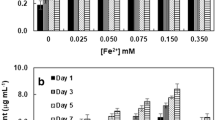Abstract
The role of a single relA/spoT homolog all1549 (designated hereafter as ana-rsh) of the cyanobacterium Anabaena sp. PCC7120 was investigated. The complementation test in Escherichia coli showed that the protein encoded by ana-rsh possesses guanosine tetraphosphate (p)ppGpp-synthase/hydrolase activity. Under laboratory growth conditions, a low level of ppGpp was detected in Anabaena sp. PCC7120 and the loss of ana-rsh was lethal. Amino acid starvation induced ppGpp accumulation to an appropriate level, and nitrogen deficiency did not alter the ppGpp concentration in Anabaena cells. These data suggest that ana-rsh is required for cell viability under normal growth conditions and involved in the (p)ppGpp-related stringent response to amino acid deprivation, but not related to heterocyst formation and nitrogen fixation of Anabaena sp. PCC7120.




Similar content being viewed by others
References
Abranches J, Martinez AR, Kajfasz JK, Chavez V, Garsin DA, Lemos JA (2009) The molecular alarmone (p)ppGpp mediates stress responses, vancomycin tolerance, and virulence in Enterococcus faecalis. J Bacteriol 191:2248–2256
Artsimovitch I, Patlan V, Sekine S, Vassylyeva MN, Hosaka T, Ochi K, Yokoyama S, Vassylyev DG (2004) Structural basis for transcription regulation by alarmone ppGpp. Cell 117:299–310
Bennett HJ, Pearce DM, Glenn S, Taylor CM, Kuhn M, Sonenshein AL, Andrew PW, Roberts IS (2007) Characterization of relA and codY mutants of Listeria monocytogenes: identification of the CodY regulon and its role in virulence. Mol Microbiol 63:1453–1467
Black TA, Cai Y, Wolk CP (1993) Spatial expression and autoregulation of hetR, a gene involved in the control of heterocyst development in Anabaena. Mol Microbiol 9:77–84
Cashel M (2000) Stringent response. In: Lederberg J (ed) Encyclopedia of microbiology, vol 4. Academic Press, San Diego, pp 467–477
Elhai J, Wolk CP (1988) A versatile class of positive-selection vectors based on the nonviability of palindrome-containing plasmids that allows cloning into long polylinkers. Gene 68:119–138
Elhai J, Wolk CP (1988) Conjugal transfer of DNA to cyanobacteria. Method Enzymol 167:747–754
Geiger T, Goerke C, Fritz M, Schafer T, Ohlsen K, Liebeke M, Lalk M, Wolz C (2010) Role of the (p)ppGpp synthase RSH, a RelA/SpoT homolog, in stringent response and virulence of Staphylococcus aureus. Infect Immun 78:1873–1883
Gentry DR, Cashel M (1996) Mutational analysis of the Escherichia coli spoT gene identifies distinct but overlapping regions involved in ppGpp synthesis and degradation. Mol Microbiol 19:1373–1384
Hogg T, Mechold U, Malke H, Cashel M, Hilgenfeld R (2004) Conformational antagonism between opposing active sites in a bifunctional Re1A/SpoT homolog modulates (p)ppGpp metabolism during the stringent response. Cell 117:57–68
Kasai K, Usami S, Yamada T, Endo Y, Ochi K, Tozawa Y (2002) A RelA-SpoT homolog (Cr-RSH) identified in Chlamydomonas reinhardtii generates stringent factor in vivo and localizes to chloroplasts in vitro. Nucleic Acids Res 30:4985–4992
Mittenhuber G (2001) Comparative genomics and evolution of genes encoding bacterial (p)ppGpp synthetases/hydrolases (the Rel, RelA and SpoT proteins). J Mol Microbiol Biotechnol 3:585–600
Potrykus K, Cashel M (2008) (p)ppGpp: still magical? Annu Rev Microbiol 62:35–51
Van der Biezen EA, Sun J, Coleman MJ, Bibb MJ, Jones JD (2000) Arabidopsis RelA/SpoT homologs implicate (p)ppGpp in plant signaling. Proc Natl Acad Sci USA 97:3747–3752
Wang Y, Xu X (2005) Regulation by hetC of genes required for heterocyst differentiation and cell division in Anabaena sp. strain PCC 7120. J Bacteriol 187:8489–8493
Xiao H, Kalman M, Ikehara K, Zemel S, Glaser G, Cashel M (1991) Residual guanosine 3′, 5′-bispyrophosphate synthetic activity of relA null mutants can be eliminated by spoT null mutations. J Biol Chem 266:5980–5990
Zhang Z, Yao L, Hou Y (1990) Construction and application of a high level expression vector containing PRPL. Chin J Virol 6:111–116
Acknowledgments
This study was supported by the National Natural Science Foundation of China (30771176).
Author information
Authors and Affiliations
Corresponding author
Rights and permissions
About this article
Cite this article
Ning, D., Qian, Y., Miao, X. et al. Role of the all1549 (ana-rsh) Gene, A relA/spoT Homolog, of the Cyanobacterium Anabaena sp. PCC7120. Curr Microbiol 62, 1767–1773 (2011). https://doi.org/10.1007/s00284-011-9926-0
Received:
Accepted:
Published:
Issue Date:
DOI: https://doi.org/10.1007/s00284-011-9926-0




